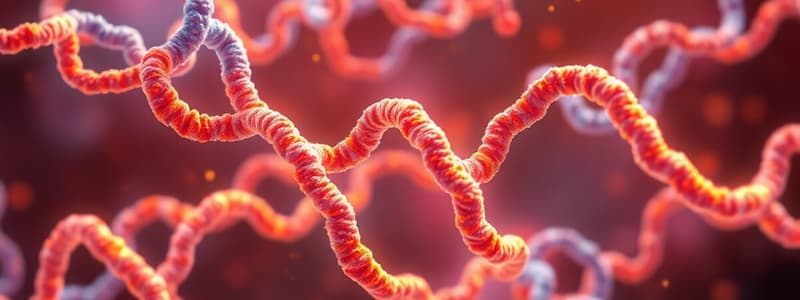Podcast
Questions and Answers
Which of the following terms describes the process of linking monomers to form macromolecules?
Which of the following terms describes the process of linking monomers to form macromolecules?
- Dehydration synthesis (correct)
- Monomer fusion
- Polymerization
- Hydrolysis
What is the monomer unit that makes up nucleic acids?
What is the monomer unit that makes up nucleic acids?
- Nucleotide (correct)
- Fatty acid
- Amino acid
- Monosaccharide
What type of bond forms during the dehydration synthesis of nucleic acids?
What type of bond forms during the dehydration synthesis of nucleic acids?
- Ester bond
- Phosphodiester bond (correct)
- Hydrogen bond
- Peptide bond
Which components are not part of a nucleotide?
Which components are not part of a nucleotide?
Which of the following is a purine nitrogenous base in nucleic acids?
Which of the following is a purine nitrogenous base in nucleic acids?
What is the reverse process of dehydration synthesis that splits macromolecules apart?
What is the reverse process of dehydration synthesis that splits macromolecules apart?
How many strands are present in a DNA molecule?
How many strands are present in a DNA molecule?
Which of the following accurately describes a polynucleotide?
Which of the following accurately describes a polynucleotide?
What type of bond connects complementary nitrogenous bases in DNA strands?
What type of bond connects complementary nitrogenous bases in DNA strands?
Which of the following statements about Chargaff's rules is accurate?
Which of the following statements about Chargaff's rules is accurate?
What structure do proteins exhibit at the primary level?
What structure do proteins exhibit at the primary level?
What is the process called through which peptide bonds are formed?
What is the process called through which peptide bonds are formed?
Which amino acid feature determines its name and specific function?
Which amino acid feature determines its name and specific function?
At which level of protein structure do interactions between various polypeptide chains occur?
At which level of protein structure do interactions between various polypeptide chains occur?
How many different amino acids are commonly recognized?
How many different amino acids are commonly recognized?
In DNA, what type of nitrogenous base pairing does cytosine (C) engage in?
In DNA, what type of nitrogenous base pairing does cytosine (C) engage in?
Flashcards are hidden until you start studying
Study Notes
Macromolecules Overview
- Macromolecules consist of chains of smaller units called monomers, forming polymers.
- Dehydration synthesis refers to the process of monomers joining together, losing water in the process.
- Hydrolysis is the splitting of monomers using water, the reverse reaction of dehydration synthesis.
Nucleic Acids
- Nucleic acids, including DNA and RNA, are the most complex macromolecules.
- They store genetic information required for protein synthesis, cell growth, and replication.
- Monomers: Nucleotide; Polymers: Polynucleotide.
- Nucleotides consist of a phosphate group, sugar (different in DNA and RNA), and a nitrogenous base (A, T, C, G).
- The sugar-phosphate backbone supports nitrogenous bases which form the structure of DNA and RNA.
Nitrogenous Bases
- Nitrogenous bases include adenine (A), thymine (T), guanine (G), and cytosine (C).
- Base pairing rules: Adenine pairs with thymine (A-T), and guanine pairs with cytosine (G-C).
- C-G pairs are linked by three hydrogen bonds, while A-T pairs have two, highlighting differences in bonding strength.
Chargaff's Rules
- Chargaff discovered proportional relationships in nitrogenous bases: %A = %T and %C = %G.
- This established the concept that purines (A, G) equal pyrimidines (T, C) in DNA.
DNA Structure
- DNA is double-stranded with strands running in opposite (antiparallel) directions.
- Strands align such that nitrogenous bases pair through hydrogen bonds.
Proteins
- Proteins are macromolecules composed of amino acids, crucial for cellular structure and function.
- Monomer: Amino acid; Polymer: Polypeptide.
- Dehydration synthesis in proteins forms peptide bonds between amino acids.
Amino Acid Structure
- There are 20 different amino acids, each with distinct side chains (R groups) contributing to their function.
- The carboxyl group of amino acids transforms into a carbonyl group after dehydration synthesis.
Protein Structure Levels
- Proteins have four levels of structural organization:
- Primary Structure: Sequence of amino acids in a polypeptide chain.
- Secondary Structure: Folding of the polypeptide, forming alpha helices and beta-pleated sheets through hydrogen bonds.
- Tertiary Structure: Interactions among helices and sheets lead to further folding of the polypeptide.
- Quaternary Structure: Assembly of multiple polypeptides into a single functional protein.
Study Recommendations
- Review the structures and functions of nucleic acids and proteins.
- Familiarize with macromolecule synthesis and splitting processes.
- Consider the significance of amino acid properties in determining protein function.
- Understand the importance of hydrogen bonds in maintaining macromolecular structures.
Studying That Suits You
Use AI to generate personalized quizzes and flashcards to suit your learning preferences.




